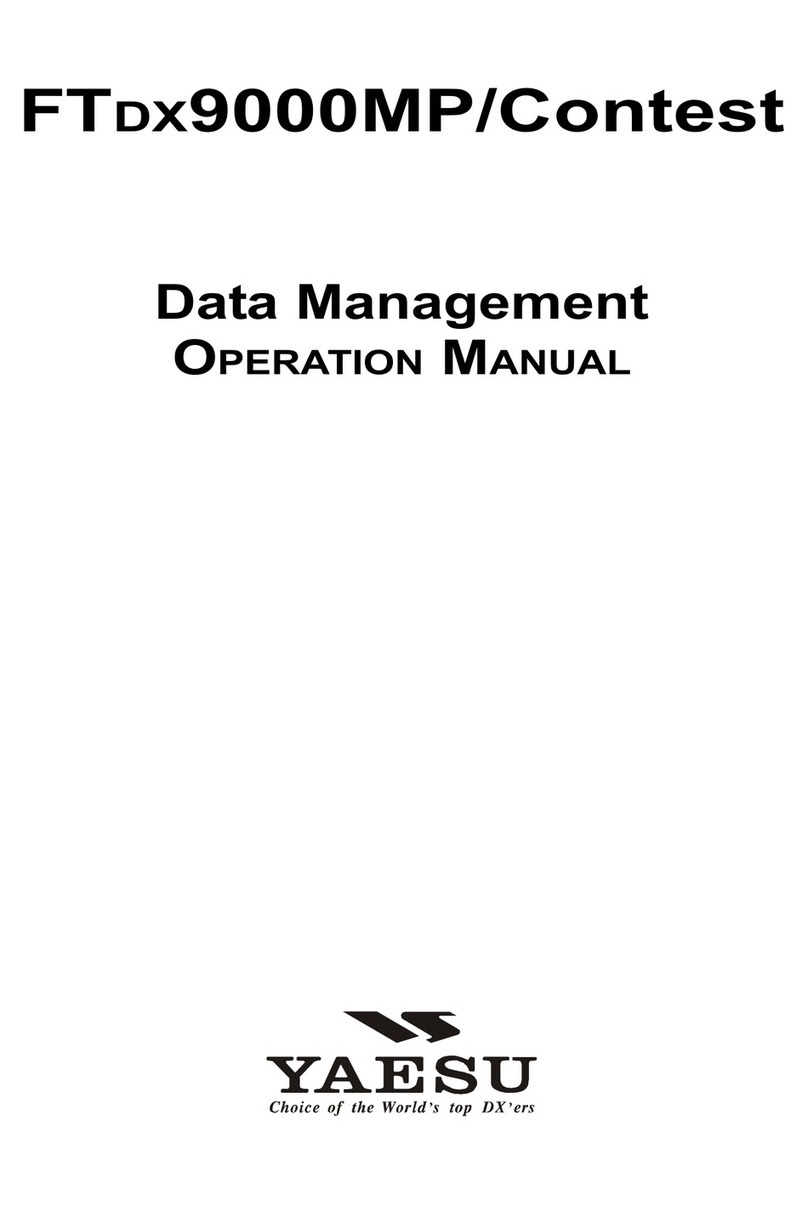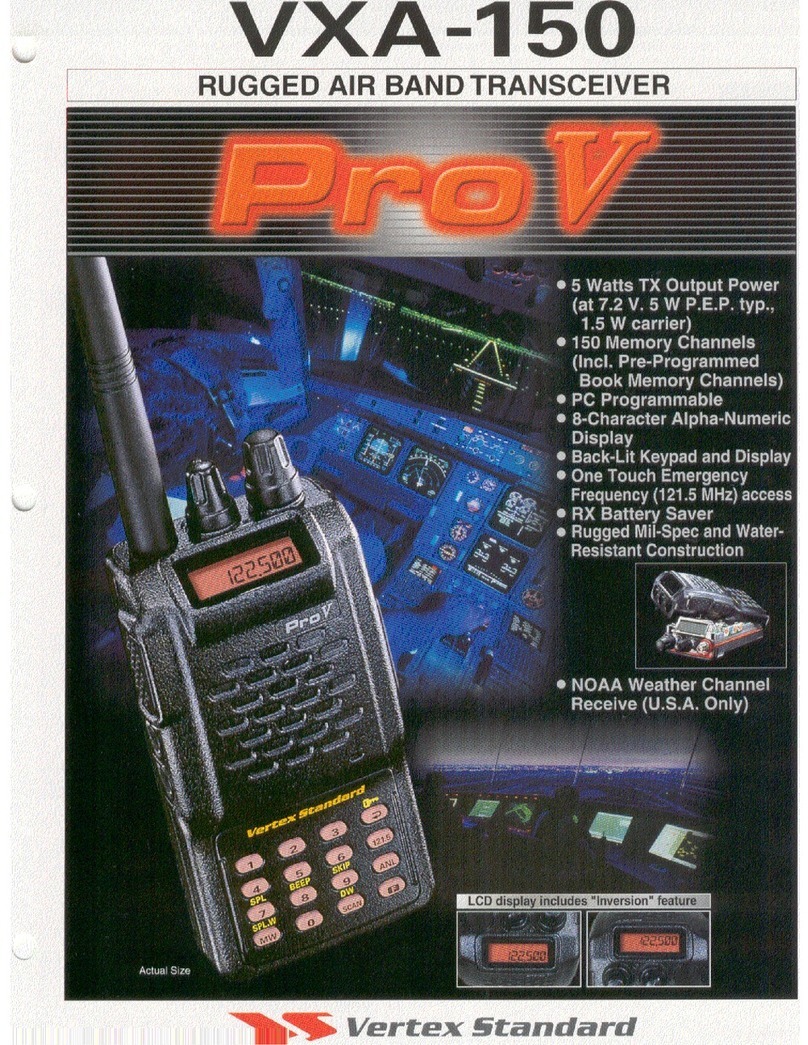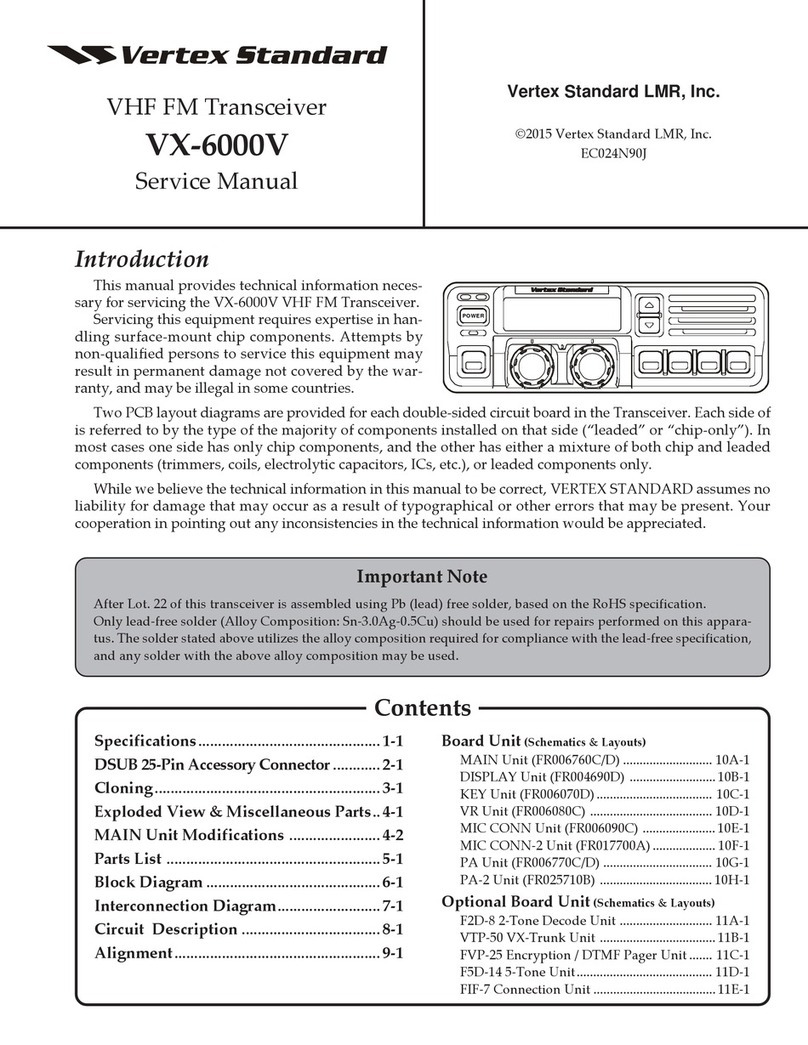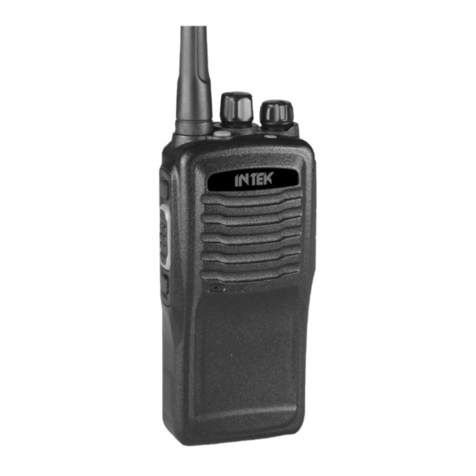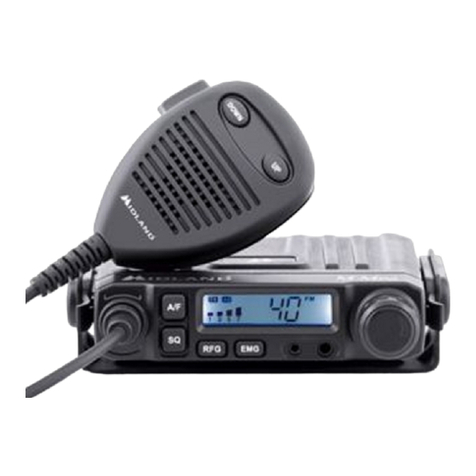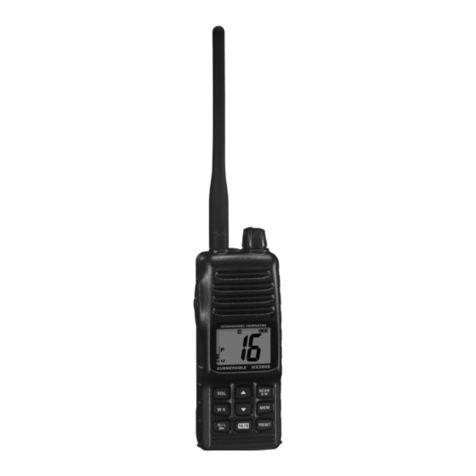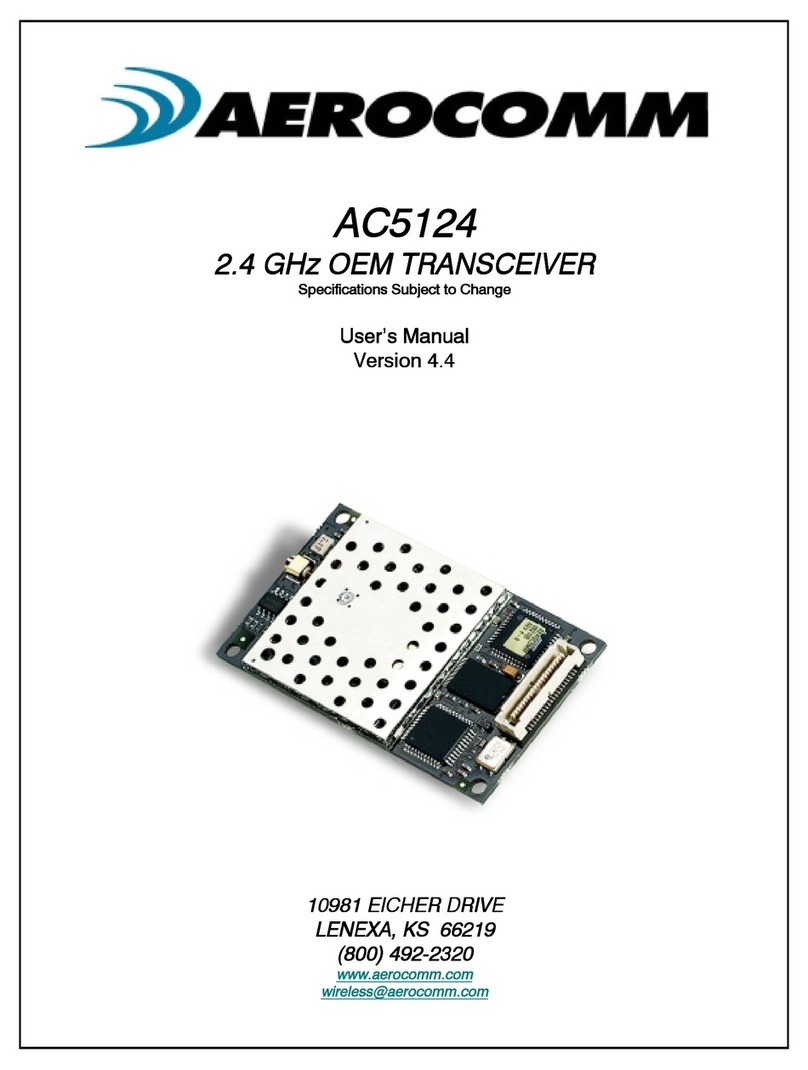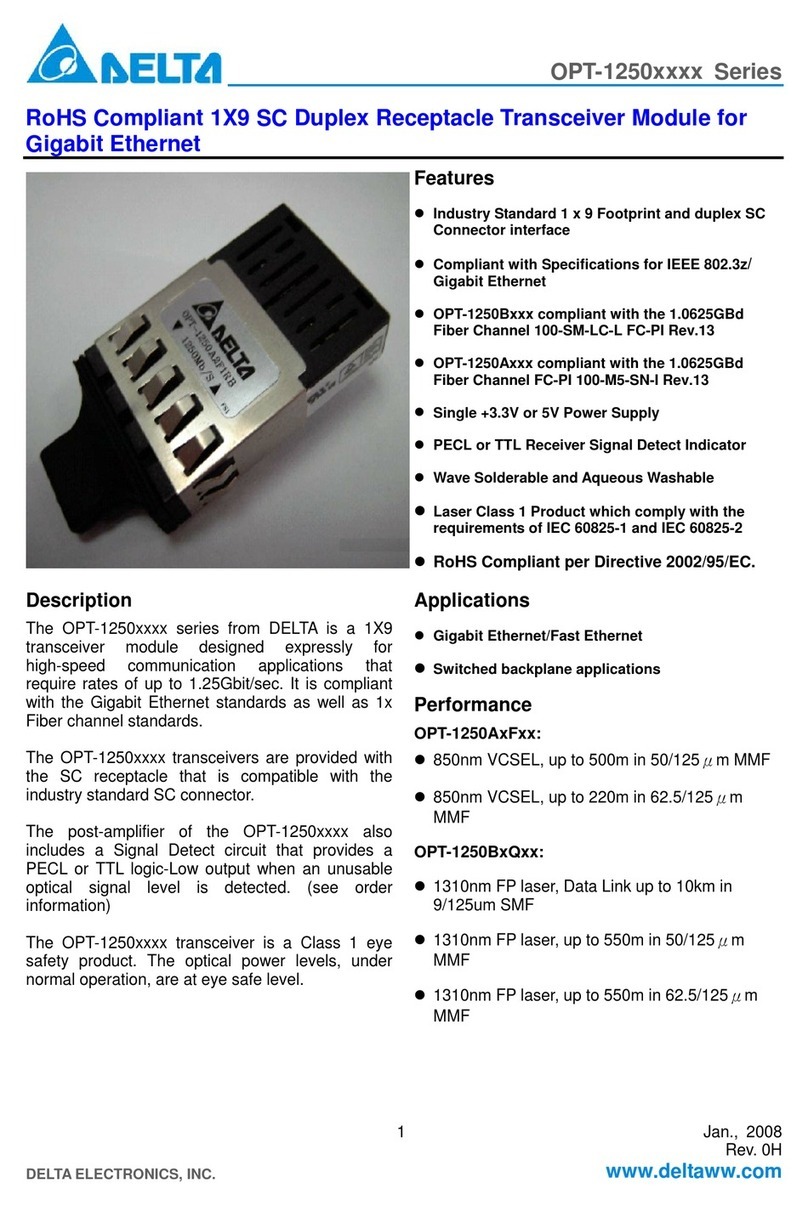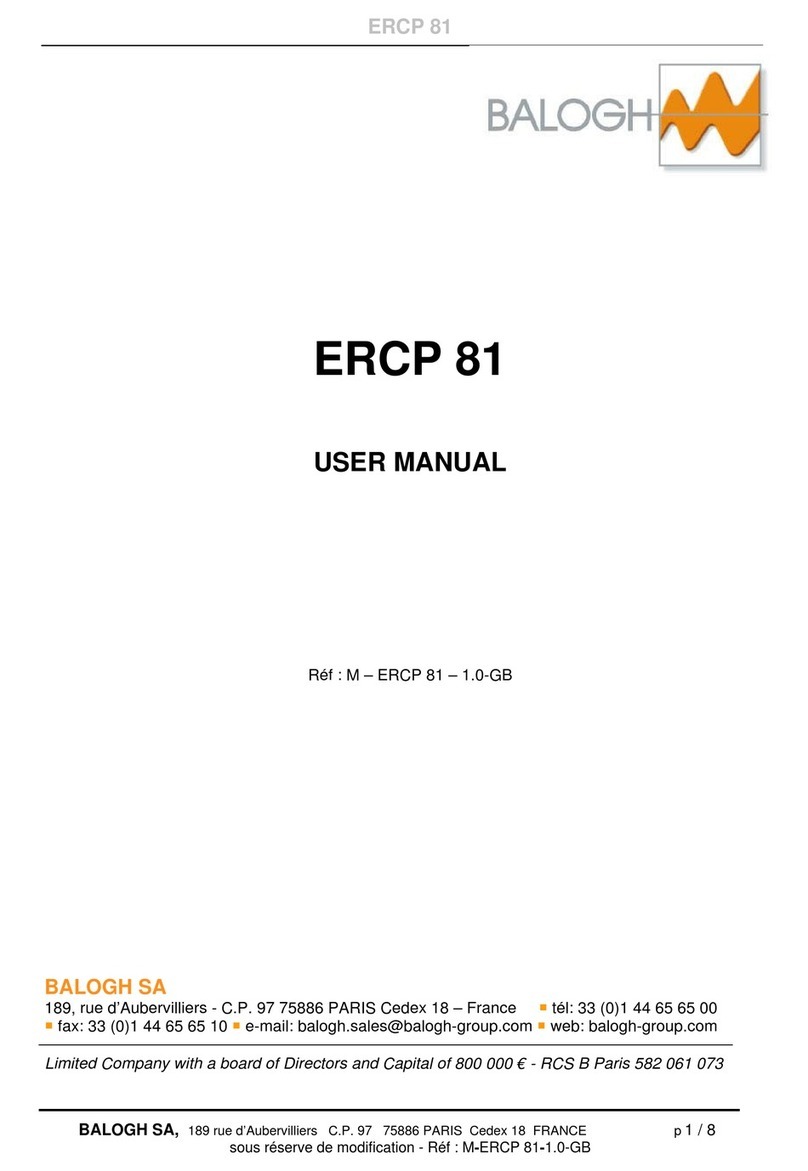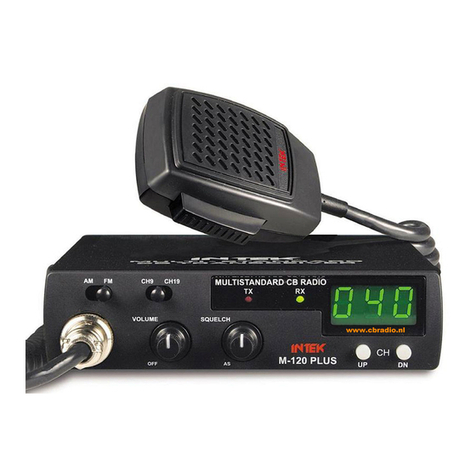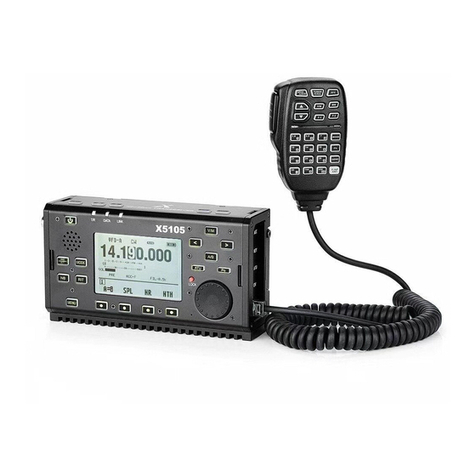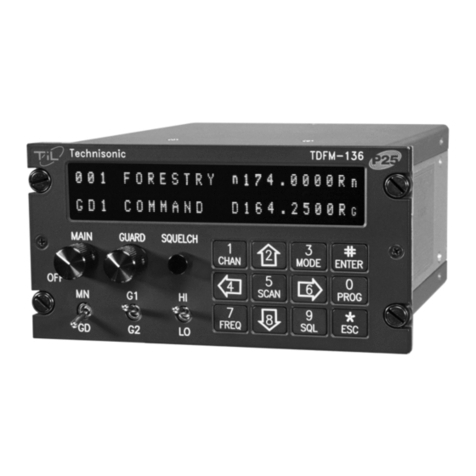Linx HumPRO Series User manual

HumPROTM Series
Master Development System
User's Guide

Table of Contents
1 Introduction
2 Ordering Information
2 HumPROTM Series Transceiver Carrier Board
2 HumPROTM Series Transceiver Carrier Board Objects
3 HumPROTM Series Carrier Board Pin Assignments
3 Programming Dock
3 Programming Dock Objects
4 Prototype Board
4 Prototype Board Objects
5 Initial Setup
6 Using the Prototype Board
8 Using the Programming Dock
10 The Development Kit Demonstration Software
20 Development Kit Demonstration Software Example
24 Carrier Board Schematic
25 Programming Dock Board Schematic
29 Prototype Board Schematic
Warning: Some customers may want Linx radio frequency (“RF”)
products to control machinery or devices remotely, including machinery
or devices that can cause death, bodily injuries, and/or property
damage if improperly or inadvertently triggered, particularly in industrial
settings or other applications implicating life-safety concerns (“Life and
Property Safety Situations”).
NO OEM LINX REMOTE CONTROL OR FUNCTION MODULE
SHOULD EVER BE USED IN LIFE AND PROPERTY SAFETY
SITUATIONS. No OEM Linx Remote Control or Function Module
should be modified for Life and Property Safety Situations. Such
modification cannot provide sufficient safety and will void the product’s
regulatory certification and warranty.
Customers may use our (non-Function) Modules, Antenna and
Connectors as part of other systems in Life Safety Situations, but
only with necessary and industry appropriate redundancies and
in compliance with applicable safety standards, including without
limitation, ANSI and NFPA standards. It is solely the responsibility
of any Linx customer who uses one or more of these products to
incorporate appropriate redundancies and safety standards for the Life
and Property Safety Situation application.
Do not use this or any Linx product to trigger an action directly
from the data line or RSSI lines without a protocol or encoder/
decoder to validate the data. Without validation, any signal from
another unrelated transmitter in the environment received by the module
could inadvertently trigger the action.
All RF products are susceptible to RF interference that can prevent
communication. RF products without frequency agility or hopping
implemented are more subject to interference. This module does have
a frequency hopping protocol built in, but the developer should still be
aware of the risk of interference.
Do not use any Linx product over the limits in this data guide.
Excessive voltage or extended operation at the maximum voltage could
cause product failure. Exceeding the reflow temperature profile could
cause product failure which is not immediately evident.
Do not make any physical or electrical modifications to any Linx
product. This will void the warranty and regulatory and UL certifications
and may cause product failure which is not immediately evident.
!

– –
1
Introduction
The Linx HumPROTM Series data transceiver modules offer a simple, efficient
and cost-effective method of adding wireless capabilities to any product. The
Master Development System provides a designer with all the tools necessary
to correctly and legally incorporate the module into an end product. The
boards serve several important functions:
• Rapid Module Evaluation: The boards allow the performance of the
Linx HumPRO™ Series modules to be evaluated quickly in a user’s
environment. The development boards can be used to evaluate the range
performance of the modules.
• Application Development: A prototyping board allows the development
of custom circuits directly on the board. All signal lines are available on
headers for easy access.
• Software Development: A programming dock with a PC interface allows
development and testing of custom software applications for control of
the module.
• Design Benchmark: The boards provide a known benchmark against
which the performance of a custom design may be judged.
The Master Development System includes 2 Carrier Boards, 2 Programming
Dock Boards, 2 Prototype Boards, 4 regular or amplified HumPROTM Series
transceivers*, antennas, batteries and full documentation.
* One part is soldered to each Carrier Board
HumPROTM Master Development System
User's Guide
Figure 1: HumPROTM Series Master Development System
Revised 9/28/2017

– – – –
2 3
HumPROTM Series Transceiver Carrier Board Objects
1. HumPROTM Series Transceiver
2. MMCX RF Connector
3. Dual Row Header
4. Single Row Header
HumPROTM Series Transceiver Carrier BoardOrdering Information
Figure 2: Ordering Information
Figure 3: HumPROTM Series Transceiver Carrier Board
1
2
34
Ordering Information
Part Number Description
MDEV-***-PRO HumPROTM Series Master Development System
MDEV-A-900-PRO Amplified HumPROTM Series Master Development System
HUM-***-PRO HumPROTM Series Data Transceiver
HUM-***-PRO-CAS HumPROTM Series Data Transceiver with Castellation
Connection
HUM-***-PRO-UFL HumPROTM Series Data Transceiver with U.FL Connector
HUM-A-900-PRO-CAS Amplified HumPROTM Series High Power Data Transceiver with
Castellation Connection
HUM-A-900-PRO-UFL Amplified HumPROTM Series High Power Data Transceiver with
U.FL Connector
EVM-***-PRO HumPROTM Series Carrier Board
EVM-A-900-PRO-CAS Amplified HumPROTM Series Carrier Board, Castellation
Connection with an edge-mount RP-SMA connector
EVM-A-900-PRO-UFL Amplified HumPROTM Series Carrier Board, U.FL Connector
MDEV-PGDOCK Development System Programming Dock
MDEV-PROTO Development System Prototype Board
CON-SOC-EVM EVM Module Socket Kit
*** = Frequency; 868, 900MHz

– – – –
4 5
Programming Dock
Programming Dock Objects
1. Carrier Board Socket
2. RP-SMA Antenna Connector
3. MODE_IND LED
4. Micro USB Connector
5. LCD Display
Figure 6: Programming Dock
2
3
4
5
1
HumPROTM Series Carrier Board Pin Assignments
7 MODE_IND
9 CMD_DATA_IN
11 CMD
13 CTS
15 CMD_DATA_OUT
17 VCC
19 NC
21 NC
23 NC
25 NC
27 NC
29 NC
31 NC
33 NC
35 NC
37 NC
GND 6
RESET 8
POWER_DOWN 10
NC 12
PB 14
LNA_EN 16
NC 18
PA_EN 20
NC 22
NC 24
NC 26
NC 28
NC 30
NC 32
NC 34
NC 36
41 NC
42 NC
43 NC
44 NC
45 NC
46 BE
47 NC
48 NC
49 NC
50 NC
51 NC
52 NC
53 NC
54 NC
55 NC
56 NC
40 NC
39 CRESP
38 EX
ANTENNA 1 2-5 GND (RF Connector)
Amplied HumPROTM Series Carrier Board
Amplied HumPROTM Series Carrier Board Objects
1. Amplified HumPROTM Series Transceiver
2. Edge-mount RP-SMA RF Connector
3. Dual Row Header
4. Single Row Header
Figure 4: Amplified HumPROTM Series Transceiver Carrier Board
1
2
34
Figure 5: HumPROTM Series Transceiver Carrier Board Pin Assignments (Top View)

– – – –
6 7
Prototype Board
Prototype Board Objects
1. Carrier Board Socket
2. RP-SMA Antenna Connector
3. Micro USB Connector
4. Power Switch
5. Power LED
6. External Battery Connection
7. Prototyping Area
8. 3.3V Supply Bus
9. Ground Bus
10. USB UART Interface Lines
11. Module Interface Breakout Headers
12. Standard SMT Package Footprints
13. Command Data Interface Routing Switches (on back)
Figure 7: Prototype Board
4
1
2
3
10
6
7
8
11
5
9
11
12 13
Initial Setup
There are several boards that are included with the Development System.
The Carrier Boards have a HumPROTM Series transceiver on a daughter
board with headers. These boards snap into sockets on the other boards,
enabling the modules to be easily moved among the test boards.
There are two Programming Docks that have a socket for a Carrier
Board and a USB interface for connection to a PC. This is used with the
demonstration software included with the kit to configure the module
through its Command Data Interface.
There are two Prototype Boards that have a socket for a Carrier Board, a
USB interface and a large area of plated through holes that can be used to
develop custom circuitry. The board can be powered either from the USB
connection or an external battery.
The development software supports Windows 7 and 10; with Java 1.6 or
later.
Warning: Installing or removing a Carrier Board while power is
applied could cause permanent damage to the module. Either turn
off power to the board or unplug the USB cable before installing or
removing a Carrier Board
!

– – – –
8 9
Supply for the module is connected through R17. This can be removed and
replaced by another supply or used to measure the current consumption of
the module.
Figure 9 shows the bottom of the board.
SW1 and SW2 connect the USB interface to the Command Data Interface
lines on the module. This allows the prototype board to be used with the
development kit software or a custom application. When in the “USB
Connected position”, the module is connected to the USB interface. The
“Header Only” position connects the module to the header.
Footprints for 0603 size resistors are on most lines so that pull-ups or
pull-downs can easily be added to the lines. The pads are connected to
VCC or GND based on the most common configuration for the module. The
schematic at the end of this document shows how each line is connected.
Using the Prototype Board
Snap a Carrier Board onto the socket on the Prototype Board as shown in
Figure 8.
Connect a micro USB cable into the connector at the top of the board.
Plug the other end into a PC or any USB charger. The board is powered
by the USB bus. This board features a prototyping area to facilitate the
addition of application-specific circuitry. The prototyping area contains a
large area of plated through-holes so that external circuitry can be placed
on the board. The holes are set at 0.100” on center with a 0.040” diameter,
accommodating most industry-standard SIP and DIP packages. Footprints
for standard surface mount packages are also included to aid prototyping.
At the top of the prototyping area is a row connected to the 3.3V power
supply and at the bottom is a row connected to ground. External circuitry
can be interfaced to the transceiver through the breakout headers. The
numbers next to the headers correspond to the pin numbers on the Carrier
Board. Figure 4 shows the pin assignments for the Carrier Board.
The OVERLOAD LED indicates that that too much current is being pulled
from the USB bus. This is used to prevent damage to the parts or the bus.
The overload condition is reset once the excess current draw is removed.
Figure 8: Prototype Board with a Carrier Board
Note: The onboard 3.3-volt regulator has approximately 400mA available
for additional circuitry when plugged into a PC (60mA with the amplified
PRO). If more current is required, the user must power the board from
an external supply or a USB charger with more current capabilities, up to
1A.
Figure 9: Prototype Board Bottom Side

– – – –
10 11
Using the Programming Dock
Snap a Carrier Board onto the socket on the Programming Dock as shown
in Figure 10.
Connect a micro USB cable into the connector at the top of the board.
Plug the other end into a PC. The board is powered by the USB bus.
The demonstration software included with the kit or custom application
software can be used to configure the module through its Command
Data Interface. The LCD is used to display information about the module.
This includes the module’s local address and a custom nickname. The
nickname is entered using the development kit software and can be
any name that helps distinguish the modules from one another. This is
convenient when multiple programming docks are connected to the same
computer. Please see the development kit software section for more
information on the nicknames.
The HumPROTM Series transceiver has a serial Command Data Interface
that is used to configure and control the transceiver. This interface consists
of a standard UART with a serial command set.
Figure 10: Programming Dock with a Carrier Board
Range Testing
Several complex mathematical models exist for determining path loss in
many environments. These models vary as the transmitter and receiver are
moved from indoor operation to outdoor operation. Although these models
can provide an estimation of range performance in the field, the most
reliable method is to simply perform range tests using the modules in the
intended operational environment.
Range testing can be performed with the Programming Docks and / or
the Prototype Boards. Data can be sent across the link using the included
software or a custom microcontroller connected to the module. The RSSI is
included with the output data messages, so this can be used to qualify the
link.
As the maximum range of the link in the test area is approached, it is not
uncommon for the signal to cut in and out as the radio moves. This is
normal and can result from other interfering sources or fluctuating signal
levels due to multipath effects. This results in cancellation of the transmitted
signal as direct and reflected signals arrive at the receiver at differing times
and phases. The areas in which this occurs are commonly called “nulls”
and simply walking a little farther usually restores the signal. If the signal is
not restored, then the maximum range of the link has been reached.
To achieve maximum range, keep objects such as your hand away from
the antenna and ensure that the antenna on the transmitter has a clear and
unobstructed line-of-sight path to the receiver board. Range performance
is determined by many interdependent factors. If the range you are able to
achieve is significantly less than specified by Linx for the products you are
testing, then there is likely a problem with either the board or the ambient
RF environment in which the board is operating. First, check the battery,
switch positions, and antenna connection. Next, check the ambient RSSI
value with the transmitter turned off to determine if ambient interference
is present. High RSSI readings while the transmitter off indicate there is
interference. If this fails to resolve the issue, please contact Linx technical
support.

– – – –
12 13
The Development Kit Demonstration Software
The development kit includes software that is used to configure and control
the module through the Programming Dock. The software defaults to the
Advanced Configuration tab when modules are plugged in (Figure 11). This
window configures the module’s settings.
1. Clicking the Contact Linx, Documentation and
About labels on the left side expands them to
show additional information and links to the
latest documentation. This is shown in Figure 12.
2. The Help window shows tips and comments
about the software.
3. The active module is connected to the PC and
being configured by the software.
4. Available modules are connected to the PC but
are not currently being configured or controlled
by the software.
7
4
1
2
310
6
8
5
9
Figure 11: The Master Development System Software Advanced Configuration Tab
5. Known Modules are not currently connected to the PC, but have either
been connected to the software in the past or have been manually
entered.
6. The Memory group selects whether configurations are written to
volatile or non-volatile memory.
7. The configurations are divided into groups. The Addressing group
configures the addressing features of the module.
• The Addressing Mode (ADDMODE) menu sets the addressing mode
used by the module; either DSN, User or Extended User.
• The Auto Addressing (AUTOADDR) menu turns the automatic
addressing feature on and off.
• The MYDSN address is the module’s local address. This is configured
at the factory and cannot be changed.
• The DSN Destination Address (DESTDSN) is the address of the desired
destination module when DSN addressing mode is used.
• User Source Address (USRCID) is the module’s local address when
User and Extended User modes are used.
• User Destination Address (UDESTID) is the address of the destination
module when User and Extended User addressing modes are used.
• User ID Address Mask (UMASK) is the mask for screening incoming
packets.
• The LASTNETAD is the last address that the module assigned using
the JOIN process. This is only used if encryption is used and the
module is an administrator.
• The Compatibility (COMPAT) setting allows communication with legacy
products.
8. The Radio group configures the radio settings of the module.
• For 900MHz units, checking the ENCSMA box enables the Carrier
Sense Multiple Access feature.
• The HOPTABLE menu selects the module’s hopping pattern
• The TXPWR menu sets the module’s transmitter output power.
• The IDLE menu sets the module’s operating state as awake or asleep.
• The ARSSI measurement is the ambient RSSI in the local environment
on the current channel at the time when the read command is issued.
• The PRSSI is the RSSI measurement of the last valid packet that was
received.
Figure 12: Additional Information
11
12
13
14
16
15
17 18 19 20

– – – –
14 15
• Checking the Extended Preamble box configures the module to send a
long preamble at the beginning of every packet.
• Checking the Assured Delivery box enables RF acknowledgements
and retries when an acknowledgement is not received.
• MAXTXRETRY sets the maximum number of times that the module will
retry sending the packet before an exception is thrown.
• Checking the ENCRC box enables the CRC checks on the incoming
data. The CRC Errors box shows the number of errors since the last
power cycle or the last time the count was reset.
9. The Serial Port group configures all of the UART serial port settings.
• The UARTBAUD menu configures the serial port baud rate, which is
used by the module to set the over-the-air RF data rate.
• The Byte Count Trigger (BCTRIG) sets the number of bytes that the
UART receives before triggering the transmission of a packet.
• The UART Data Timeout (DATATO) sets the number of milliseconds
from the last character received on the UART before the module
transmits the data in its buffer.
• Selecting the WAKEACK box instructs the module to output the
acknowledgement (0x06) on the UART when the module wakes from
sleep or power cycle.
• Selecting the CMDHOLD box instructs the module to buffer any
received over-the-air data while processing configuration commands.
• Selecting the SHOWVER box instructs the module to output the
firmware version information when the module starts up from a power
cycle or reset.
10. The Packet Options group configures the explicit packet transmission
and reception, allowing the host microcontroller to control when
packets are sent and how they are received. These are set in the
PKTOPT register.
11. The Encryption Options group configures the encryption settings.
• Selecting the Encrypted Transmission box enables encryption.
• Clicking the Write Key button opens a window where the 128-bit AES
key can be entered (Figure 13).
• Clicking the Clear Key button opens a window where the key can be
cleared (Figure 13).
12. The Security Options group corresponds to the SECOPT register.
This configures the security options related to encryption and the Join
Process for setting up networks.
13. The Exceptions group configures the Extended Exception Flags and
Extended Exception Mask.
• Checking the boxes in the EEMASK0 and EEMASK1 rows sets which
exception conditions trigger the exception flags
• The EEXFLAG0 and EEXFLAG1 boxes show the current value for the
flags. 0x00 means no exceptions were detected. A non-zero value
means an exception flag is set. Clicking on the box opens a menu
showing which flags are set. Clicking on the flag clears it (Figure 14).
14. The Legacy Exception Registers group configures the Exception
Mask and Exception Flags associated with the older 250 Series
modules. These are included for backwards compatibility and are not
recommended for new designs.
15. The Module Identity group displays the RELEASE value and the
firmware version.
16. The Show Commands button opens a window that displays all of the
commands sent to the module. This is useful for seeing the UART
commands when developing and debugging firmware.
17. The Read All button reads all of the values from the active module.
18. The Write button writes all changes to the active module.
19. The Set Defaults button restores all settings to the factory defaults.
Figure 13: The Master Development System Software Write Key and Clear Key Windows
Figure 14: The Master Development System Software Exception Flags

– – – –
16 17
20. The Reset Module button issues a command to restart the module.
21. When an 868MHz module is active, the ENCSMA becomes a
drop-down menu that selects the LBT + AFA settings (Figure 15).
The modules are shown with four identifiers as shown in Figure 16.
1. The type of module (HumPRO™ or Amplified HumPROTM Series)
2. The module’s local address.
3. A custom name that can be given to the module. Type a name into
the box and press Enter to apply it. This name is shown on the LCD
display on the programming dock (Figure 17).
4. The active module has an eject symbol that disconnects the software
from that module when clicked. The Available modules have a play
symbol that makes that module active when clicked.
1
234
Figure 17: The Master Development System Programming Dock with Name and Address Displayed
21
Figure 15: The Master Development System Software 868MHz Advanced Configuration Tab
Figure 16: The Master Development System Software Module Identifiers

– – – –
18 19
The Wireless Chat tab (Figure 18) offers a demonstration of sending data
between two modules. There is a window for each connected module.
1. The top of the window shows the address or nickname of the
associated module.
2. The chat screen shows the chat messages that have been sent and
received. Transmitted messages are in pink, received are in blue.
3. The Send box is where the message text is entered. The message is
transmitted when the Send button is clicked.
4. The TX Times box shows how many times the module has transmitted.
5. The RX Count box counts the number of messages that the module
has received.
6. The Clear button clears all of the messages from the chat window.
7. The RSSI box indicates the signal strength of the last received
message.
8. When the Show As Bytes box is selected the messages are shown as
bytes in the chat window.
Figure 18: The Master Development System Software Wireless Chat Tab
7
4
1
2
3
6
8
5
9. When the Echo with RSSI box is checked, the software transmits any
message it receives and appends the received RSSI to the end of the
message.
10. The Join Status box shows the value in the JOINST register. This
indicates the state of Join activity since the module was last reset.
Clicking on the box opens a description of the value (Figure 19).
11. The Join Commands button sets the Join Process Control options in
the CMD register. Clicking on the button opens a menu of the Join
commands. Clicking on one of the commands triggers that operation
(Figure 20).
9
10 11
Figure 19: The Master Development System Software Join Status Register Description
Figure 20: The Master Development System Software Join Commands

– – – –
20 21
Figure 23: The Master Development System Software Command Set Tab Items Menu
Figure 22: The Master Development System Software Command Set Tab Commands Menu
Figure 24: The Master Development System Software Show Commands Window
The Command Set tab (Figure 21) allows specific commands to be written
to the module.
1. The Command box shows the hexadecimal values that are written to
the module. Values can be typed into the box or a command can be
selected from the Commands menu.
2. The Response box shows the hexadecimal values that are returned
from the module in response to a command.
3. The Commands drop-down menu shows all of the commands that
are available for the active module (Figure 22). Selecting one of the
commands from this menu automatically fills in the Command box. The
values can be adjusted by typing in the box.
4. The Items drop down menu displays all of the items that are available
for the active module (Figure 23). Selecting one of the items from
this menu automatically fills in the Command box. The values can be
adjusted by typing in the box.
5. Clicking Send writes the values in the Command box to the module.
6. The structure of the selected command and its response is shown in
the main window. Please see the HumPRO™ Series Transceiver Data
Guide for definitions of each value.
7. The Show Commands button opens a window that shows the bytes
sent to the module and the responses from the module (Figure 24).
4
1
23
6
Figure 21: The Master Development System Software Command Set Tab
7
5

– – – –
22 23
Any changes to the current configurations are shown in red. These
changes are not written to the module until the Submit button is clicked.
Figure 27: The Master Development System Software with Connected Modules
Figure 28: The Master Development System Software Advanced Configuration with Changes
Development Kit Demonstration Software Example
This example shows how to configure two modules to work with each
other. The software defaults to the Advanced Configuration tab when
opened (Figure 25).
Install Carrier Boards onto the Programming Docks and plug a USB cable
between the Programming Docks and the PC. The software automatically
detects attached devices. The first module that is identified appears
under the Active label. This is the module that is actively controlled by
the software. Subsequent modules are listed under the Available label as
shown in Figure 26.
Once the modules are detected by the software, the appropriate options
are displayed on the Advanced Configurations tab. The module’s
documents appear under the Documentation link.
Figure 25: The Master Development System Software Advanced Configuration Tab at Start-up
Figure 26: The Master Development System Software Connected Modules

– – – –
24 25
Text can be entered into the box. Once the Send button is clicked, the
text is transmitted to the other module. The RX Times, TX Times and RSSI
boxes display data that can be used to qualify the integrity of the link.
The modules can be used with two computers for range testing. Install the
Master Development System software on both computers. Connect both
modules to both computers so that the software learns them. Now one
module can be used with each computer to form a link.
When using both modules in close proximity to each other, such as when
both are connected to one connected to one computer for testing, it is
a good idea to set the transmitter output power to a low level. At short
ranges and high output power levels the receivers can become saturated
and miss packets.
Figure 30: The Master Development System Software Wireless Chat Tab
Changing the active module is accomplished by clicking the play symbol
next to the desired module. Changes can now be made to this module.
There are several settings that must match in order for the modules to be
able to communicate. This example uses the following settings.
• Addressing mode is DSN
• The DSN Destination Address is the DSN address of the other module.
In this example, the module with the 346FA9FC DSN Source Address
has the DSN Destination Address of 6DCD70E2 and vice versa.
• The Hopping Pattern is 1.
• The UART Baud Rate is 38400.
Other settings can be used as long as they match on both modules. Once
the settings are changed and submitted to both modules, the Wireless
Chat tab can be used to transfer data.
Figure 29: The Master Development System Software Advanced Configuration with Changes Written

– – – –
26 27
NC
38
39
40
41
42
43
44
45
46
47
48
49
50
51
52
53
54
55
56
BE
EX
CRESP
NC6
NC5
NC4
NC3
NC2
NC1PB
MODE_IND
CMD
CTS
RESET
PDN
NC9
CMD_DATA_IN
CMD_DATA_OUT
LNA_EN
PB
PA_EN
RESETPDN
NC9
LNA_EN
MODE_IND
CMD
CTS
BE
EX
CRESP
NC6
NC5
NC4
NC3
NC2
NC1 NC7
NC8
NC7
NC8
1
23
45
67
89
10 11
12 13
14 15
16 17
18 19
20 21
22 23
24 25
26 27
28 29
30 31
32 33
34 35
36 37
J1
Carrier Interconnect
CMD_DATA_OUT
CMD_DATA_IN
X1
1.2pF
X2 5.3nH
GND
GND
GND
GND
GND
GND
GND
GND
GND
GND
GND
GND
GND
GND
VCC
VCC
PA_EN
GND 17
VCC 21
GND 18
RESET 22
LNA_EN 23
PA_EN 24
CMD_DATA_OUT 26
CMD_DATA_IN 27
CTS 28
PB 29
NC
2
GND 25
1
MODE_IND
30
BE
31
NC
32
NC
3
NC
4
ANT 19
GND 20
NC
5
NC
6
CRESP
7
EX
8
NC
10
NC
11
POWER_DOWN
12
CMD
13
GND
9
GND 16
GND 15
GND 14
TR1
X3
DNP
GND
HUM-***-PRO
Figure 31: HumPROTM Series Transceiver Carrier Board Schematic
Carrier Board Schematic
CD_IN
CD_OUT
67
89
10 11
12 13
14 15
16 17
18 19
20 21
22 23
24 25
26 27
28 29
30 31
32 33
34 35
36 37
GND
VCC
R1
10k
VCC
J1-2
nCMD
nCTS
PB
nPDN
MODE_IND
nRESET
38
39
40
41
42
43
44
45
46
47
48
49
50
51
52
53
54
55
56
R3
2k
VCC
ID
J1-3
BE
R2
2k
VCC
ID2
RF
1
GND
2
J2
GND
CMD
NC
1
NC
2
NC
3
BE
4
NC
5
NC
6
NC
7
NC
8
GND
9
NC
10
NC
11
EX
12
CRESP
13
PB
14
CMD_DATA_OUT
15
CMD_DATA_IN
16
NC
17
NC
18
NC
19
NC
20
NC
21
VCC
22
GND 32
ANT 33
CTS 34
35
MODE_IND 36
NC 37
NC 38
NC 39
RESET 40
NC 41
NC 42
PDN 43
NC 44
U1
HUM-A-fff-CAS
nRESET
PB
CD_IN
BE
nCTS
CD_OUT
VCC
nCMD
MODE_IND
nPDN
GND
GND
EX
nCRESP
EX
nCRESP
Figure 32: Amplified HumPROTM Series Transceiver Carrier Board Schematic
Amplied Carrier Board Schematic

– – – –
28 29
GND
+C8
100uF
VCC
GND
Vin
1
GND
2
Vout 3
U4
LM3940IMP 3.3V
C9
0.47uF
GND
IN
1
GND
2
EN
3FAULT 4
ILIM 5
OUT 6
U3
TPS2552
GND
5VUSB
GND
R11
53.6k
PWREN#
USB AREA POWER SUPPLY AREA RF MODULE CARRIER AREA
SIGNAL ROUTING
U8
VDC
1
RA5
2
RA4
3
MCLR
4
RC5
5
RC4
6
RC3
7RC2 8
RC1 9
RC0 10
RA2 11
ICSPCLK 12
ICSPDAT 13
GND 14
PIC16F1825-I/ST
VCC GND
PGM
CSB RS
SI
SCL
RST
PGC
PGD
R42 DNP
VCCP
VCC
RS
SI
SCL
RST
CSB
VCC
GND
GND
C13
1uF
GND
C14
1uF C1-
2
C1+
3
VOUT
4
VCC
5
GND
6
SI
7
SCL
8
CSB
9
RS
10
LED+
1
LED-
12
RST
11
LCD1
2x16 LCD
R6
0 Ohm
MICROCONTROLLER AREA
D2
GND
GND
+
C1
4.7uF
C4
0.01uF
L1
600R/1.3A
GND
C6
47pF
R4
0
C2
0.1uF
VCC 12
VCCIO 3
3V3OUT
10
GND
5
GND
13
USBDM
9
USBDP
8
RESET#
11
TXD 1
RXD 4
RTS# 2
CTS# 6
CBUS0 15
CBUS1 14
CBUS2 7
CBUS3 16
U2
FT230X
C5
47pF
PWREN#
C7
0.1uF
GND
5V 1
DAT- 2
DAT+ 3
NC 4
GSHD
6GSHD
7
GND 5
J1
Micro USB
5VUSB
RTS
R2 27
R3 27
TXD
RXD
nCTS
VCC
R20
10k
R47 DNP
GPIO2
RXTXLED
D1
R5
330 ohm
ORANGE
RXTXLED
VCC
R17
10k
GND
NC
1
IN
2
GND
3OUT 4
VCC 5
U5 VCC
GND
R49 DNP
Buffer Bypass DNP
RTS nCMD
CMD_DATA_OUTRXD
NC
1
IN
2
GND
3OUT 4
VCC 5
U1 VCC
GND
R46
10k
VCC
R48 DNP
CMD_DATA_INTXD
Buffer Bypass DNP
GND
MODE_IND
R8
330 ohm
D4
MODE_IND BLUE
R24
10k
S2
VCC
PAIR
PAIR
GND
R41
0 ohm
R40
0 ohm
VCC
GND
SW1
LADJ
R36
DNP
R23
DNP
GPIO1
RXD
GND
nPDN
R9 10k GND
38
39
40
41
42
43
44
45
46
47
48
49
50
51
52
53
54
55
56
GND
GND
GND
GND
GND
GND
GND
GND
GND
GND
GND
GND
GND
R35 10k
R34 10k
R33 10k
R32 10k
R30 10k
R28 10k
R22 10k
R21 10k
R18 10k
R15 10k
R14 10k
R13 10k
R12 10k
R10 10k
GND
R38 10k VCC
R16
10k
VCC
VCC
R1
1 Ohm
MODE_IND
CMD_DATA_IN
CMD_DATA_OUT
GND
GND
GNDGND
GND
1
23
45
67
89
10 11
12 13
14 15
16 17
18 19
20 21
22 23
24 25
26 27
28 29
30 31
32 33
34 35
36 37
J2
Carrier Interconnect
R29 10k
GND
GND
VCC
VCC
R27 10k
R25 10k
R1910k
R3110k
VCC
PAIR
GND R2610k
GND R3710k
GND R3910k
GND R4310k
R44 10k GND
R45 10k GND
RF 1
GND
2-5
ANT1
GND
GND
X1
1nH X3
DNP
GND
X2
DNP
LADJ
nPDN nCMD
nCTS
CMD_DATA_IN
GPIO1
GPIO2
GPIO1
Figure 33: Programming Dock Board RF Carrier Area Schematic
Programming Dock Board Schematic
GND
+C8
100uF
VCC
GND
Vin
1
GND
2
Vout 3
U4
LM3940IMP 3.3V
C9
0.47uF
GND
IN
1
GND
2
EN
3FAULT 4
ILIM 5
OUT 6
U3
TPS2552
GND
5VUSB
GND
R11
53.6k
PWREN#
USB AREA POWER SUPPLY AREA RF MODULE CARRIER AREA
SIGNAL ROUTING
U8
VDC
1
RA5
2
RA4
3
MCLR
4
RC5
5
RC4
6
RC3
7RC2 8
RC1 9
RC0 10
RA2 11
ICSPCLK 12
ICSPDAT 13
GND 14
PIC16F1825-I/ST
VCC GND
PGM
CSB RS
SI
SCL
RST
PGC
PGD
R42 DNP
VCCP
VCC
RS
SI
SCL
RST
CSB
VCC
GND
GND
C13
1uF
GND
C14
1uF C1-
2
C1+
3
VOUT
4
VCC
5
GND
6
SI
7
SCL
8
CSB
9
RS
10
LED+
1
LED-
12
RST
11
LCD1
2x16 LCD
R6
0 Ohm
MICROCONTROLLER AREA
D2
GND
GND
+
C1
4.7uF
C4
0.01uF
L1
600R/1.3A
GND
C6
47pF
R4
0
C2
0.1uF
VCC 12
VCCIO 3
3V3OUT
10
GND
5
GND
13
USBDM
9
USBDP
8
RESET#
11
TXD 1
RXD 4
RTS# 2
CTS# 6
CBUS0 15
CBUS1 14
CBUS2 7
CBUS3 16
U2
FT230X
C5
47pF
PWREN#
C7
0.1uF
GND
5V 1
DAT- 2
DAT+ 3
NC 4
GSHD
6GSHD
7
GND 5
J1
Micro USB
5VUSB
RTS
R2 27
R3 27
TXD
RXD
nCTS
VCC
R20
10k
R47 DNP
GPIO2
RXTXLED
D1
R5
330 ohm
ORANGE
RXTXLED
VCC
R17
10k
GND
NC
1
IN
2
GND
3OUT 4
VCC 5
U5 VCC
GND
R49 DNP
Buffer Bypass DNP
RTS nCMD
CMD_DATA_OUTRXD
NC
1
IN
2
GND
3OUT 4
VCC 5
U1 VCC
GND
R46
10k
VCC
R48 DNP
CMD_DATA_INTXD
Buffer Bypass DNP
GND
MODE_IND
R8
330 ohm
D4
MODE_IND BLUE
R24
10k
S2
VCC
PAIR
PAIR
GND
R41
0 ohm
R40
0 ohm
VCC
GND
SW1
LADJ
R36
DNP
R23
DNP
GPIO1
RXD
GND
nPDN
R9 10k GND
38
39
40
41
42
43
44
45
46
47
48
49
50
51
52
53
54
55
56
GND
GND
GND
GND
GND
GND
GND
GND
GND
GND
GND
GND
GND
R35 10k
R34 10k
R33 10k
R32 10k
R30 10k
R28 10k
R22 10k
R21 10k
R18 10k
R15 10k
R14 10k
R13 10k
R12 10k
R10 10k
GND
R38 10k VCC
R16
10k
VCC
VCC
R1
1 Ohm
MODE_IND
CMD_DATA_IN
CMD_DATA_OUT
GND
GND
GNDGND
GND
1
23
45
67
89
10 11
12 13
14 15
16 17
18 19
20 21
22 23
24 25
26 27
28 29
30 31
32 33
34 35
36 37
J2
Carrier Interconnect
R29 10k
GND
GND
VCC
VCC
R27 10k
R25 10k
R1910k
R3110k
VCC
PAIR
GND R2610k
GND R3710k
GND R3910k
GND R4310k
R44 10k GND
R45 10k GND
RF 1
GND
2-5
ANT1
GND
GND
X1
1nH X3
DNP
GND
X2
DNP
LADJ
nPDN nCMD
nCTS
CMD_DATA_IN
GPIO1
GPIO2
GPIO1
Figure 34: Programming Dock Board Power Supply Area Schematic
GND
+C8
100uF
VCC
GND
Vin
1
GND
2
Vout 3
U4
LM3940IMP 3.3V
C9
0.47uF
GND
IN
1
GND
2
EN
3FAULT 4
ILIM 5
OUT 6
U3
TPS2552
GND
5VUSB
GND
R11
53.6k
PWREN#
USB AREA POWER SUPPLY AREA RF MODULE CARRIER AREA
SIGNAL ROUTING
U8
VDC
1
RA5
2
RA4
3
MCLR
4
RC5
5
RC4
6
RC3
7RC2 8
RC1 9
RC0 10
RA2 11
ICSPCLK 12
ICSPDAT 13
GND 14
PIC16F1825-I/ST
VCC GND
PGM
CSB RS
SI
SCL
RST
PGC
PGD
R42 DNP
VCCP
VCC
RS
SI
SCL
RST
CSB
VCC
GND
GND
C13
1uF
GND
C14
1uF C1-
2
C1+
3
VOUT
4
VCC
5
GND
6
SI
7
SCL
8
CSB
9
RS
10
LED+
1
LED-
12
RST
11
LCD1
2x16 LCD
R6
0 Ohm
MICROCONTROLLER AREA
D2
GND
GND
+
C1
4.7uF
C4
0.01uF
L1
600R/1.3A
GND
C6
47pF
R4
0
C2
0.1uF
VCC 12
VCCIO 3
3V3OUT
10
GND
5
GND
13
USBDM
9
USBDP
8
RESET#
11
TXD 1
RXD 4
RTS# 2
CTS# 6
CBUS0 15
CBUS1 14
CBUS2 7
CBUS3 16
U2
FT230X
C5
47pF
PWREN#
C7
0.1uF
GND
5V 1
DAT- 2
DAT+ 3
NC 4
GSHD
6GSHD
7
GND 5
J1
Micro USB
5VUSB
RTS
R2 27
R3 27
TXD
RXD
nCTS
VCC
R20
10k
R47 DNP
GPIO2
RXTXLED
D1
R5
330 ohm
ORANGE
RXTXLED
VCC
R17
10k
GND
NC
1
IN
2
GND
3OUT 4
VCC 5
U5 VCC
GND
R49 DNP
Buffer Bypass DNP
RTS nCMD
CMD_DATA_OUTRXD
NC
1
IN
2
GND
3OUT 4
VCC 5
U1 VCC
GND
R46
10k
VCC
R48 DNP
CMD_DATA_INTXD
Buffer Bypass DNP
GND
MODE_IND
R8
330 ohm
D4
MODE_IND BLUE
R24
10k
S2
VCC
PAIR
PAIR
GND
R41
0 ohm
R40
0 ohm
VCC
GND
SW1
LADJ
R36
DNP
R23
DNP
GPIO1
RXD
GND
nPDN
R9 10k GND
38
39
40
41
42
43
44
45
46
47
48
49
50
51
52
53
54
55
56
GND
GND
GND
GND
GND
GND
GND
GND
GND
GND
GND
GND
GND
R35 10k
R34 10k
R33 10k
R32 10k
R30 10k
R28 10k
R22 10k
R21 10k
R18 10k
R15 10k
R14 10k
R13 10k
R12 10k
R10 10k
GND
R38 10k VCC
R16
10k
VCC
VCC
R1
1 Ohm
MODE_IND
CMD_DATA_IN
CMD_DATA_OUT
GND
GND
GNDGND
GND
1
23
45
67
89
10 11
12 13
14 15
16 17
18 19
20 21
22 23
24 25
26 27
28 29
30 31
32 33
34 35
36 37
J2
Carrier Interconnect
R29 10k
GND
GND
VCC
VCC
R27 10k
R25 10k
R1910k
R3110k
VCC
PAIR
GND R2610k
GND R3710k
GND R3910k
GND R4310k
R44 10k GND
R45 10k GND
RF 1
GND
2-5
ANT1
GND
GND
X1
1nH X3
DNP
GND
X2
DNP
LADJ
nPDN nCMD
nCTS
CMD_DATA_IN
GPIO1
GPIO2
GPIO1
Figure 35: Programming Dock Board Signal Routing Schematic

– – – –
30 31
GND
+C8
100uF
VCC
GND
Vin
1
GND
2
Vout 3
U4
LM3940IMP 3.3V
C9
0.47uF
GND
IN
1
GND
2
EN
3FAULT 4
ILIM 5
OUT 6
U3
TPS2552
GND
5VUSB
GND
R11
53.6k
PWREN#
USB AREA POWER SUPPLY AREA RF MODULE CARRIER AREA
SIGNAL ROUTING
U8
VDC
1
RA5
2
RA4
3
MCLR
4
RC5
5
RC4
6
RC3
7RC2 8
RC1 9
RC0 10
RA2 11
ICSPCLK 12
ICSPDAT 13
GND 14
PIC16F1825-I/ST
VCC GND
PGM
CSB RS
SI
SCL
RST
PGC
PGD
R42 DNP
VCCP
VCC
RS
SI
SCL
RST
CSB
VCC
GND
GND
C13
1uF
GND
C14
1uF C1-
2
C1+
3
VOUT
4
VCC
5
GND
6
SI
7
SCL
8
CSB
9
RS
10
LED+
1
LED-
12
RST
11
LCD1
2x16 LCD
R6
0 Ohm
MICROCONTROLLER AREA
D2
GND
GND
+
C1
4.7uF
C4
0.01uF
L1
600R/1.3A
GND
C6
47pF
R4
0
C2
0.1uF
VCC 12
VCCIO 3
3V3OUT
10
GND
5
GND
13
USBDM
9
USBDP
8
RESET#
11
TXD 1
RXD 4
RTS# 2
CTS# 6
CBUS0 15
CBUS1 14
CBUS2 7
CBUS3 16
U2
FT230X
C5
47pF
PWREN#
C7
0.1uF
GND
5V 1
DAT- 2
DAT+ 3
NC 4
GSHD
6GSHD
7
GND 5
J1
Micro USB
5VUSB
RTS
R2 27
R3 27
TXD
RXD
nCTS
VCC
R20
10k
R47 DNP
GPIO2
RXTXLED
D1
R5
330 ohm
ORANGE
RXTXLED
VCC
R17
10k
GND
NC
1
IN
2
GND
3OUT 4
VCC 5
U5 VCC
GND
R49 DNP
Buffer Bypass DNP
RTS nCMD
CMD_DATA_OUTRXD
NC
1
IN
2
GND
3OUT 4
VCC 5
U1 VCC
GND
R46
10k
VCC
R48 DNP
CMD_DATA_INTXD
Buffer Bypass DNP
GND
MODE_IND
R8
330 ohm
D4
MODE_IND BLUE
R24
10k
S2
VCC
PAIR
PAIR
GND
R41
0 ohm
R40
0 ohm
VCC
GND
SW1
LADJ
R36
DNP
R23
DNP
GPIO1
RXD
GND
nPDN
R9 10k GND
38
39
40
41
42
43
44
45
46
47
48
49
50
51
52
53
54
55
56
GND
GND
GND
GND
GND
GND
GND
GND
GND
GND
GND
GND
GND
R35 10k
R34 10k
R33 10k
R32 10k
R30 10k
R28 10k
R22 10k
R21 10k
R18 10k
R15 10k
R14 10k
R13 10k
R12 10k
R10 10k
GND
R38 10k VCC
R16
10k
VCC
VCC
R1
1 Ohm
MODE_IND
CMD_DATA_IN
CMD_DATA_OUT
GND
GND
GNDGND
GND
1
23
45
67
89
10 11
12 13
14 15
16 17
18 19
20 21
22 23
24 25
26 27
28 29
30 31
32 33
34 35
36 37
J2
Carrier Interconnect
R29 10k
GND
GND
VCC
VCC
R27 10k
R25 10k
R1910k
R3110k
VCC
PAIR
GND R2610k
GND R3710k
GND R3910k
GND R4310k
R44 10k GND
R45 10k GND
RF 1
GND
2-5
ANT1
GND
GND
X1
1nH X3
DNP
GND
X2
DNP
LADJ
nPDN nCMD
nCTS
CMD_DATA_IN
GPIO1
GPIO2
GPIO1
Figure 36: Programming Dock Board USB Area Schematic
GND
+C8
100uF
VCC
GND
Vin
1
GND
2
Vout 3
U4
LM3940IMP 3.3V
C9
0.47uF
GND
IN
1
GND
2
EN
3FAULT 4
ILIM 5
OUT 6
U3
TPS2552
GND
5VUSB
GND
R11
53.6k
PWREN#
USB AREA POWER SUPPLY AREA RF MODULE CARRIER AREA
SIGNAL ROUTING
U8
VDC
1
RA5
2
RA4
3
MCLR
4
RC5
5
RC4
6
RC3
7RC2 8
RC1 9
RC0 10
RA2 11
ICSPCLK 12
ICSPDAT 13
GND 14
PIC16F1825-I/ST
VCC GND
PGM
CSB RS
SI
SCL
RST
PGC
PGD
R42 DNP
VCCP
VCC
RS
SI
SCL
RST
CSB
VCC
GND
GND
C13
1uF
GND
C14
1uF C1-
2
C1+
3
VOUT
4
VCC
5
GND
6
SI
7
SCL
8
CSB
9
RS
10
LED+
1
LED-
12
RST
11
LCD1
2x16 LCD
R6
0 Ohm
MICROCONTROLLER AREA
D2
GND
GND
+
C1
4.7uF
C4
0.01uF
L1
600R/1.3A
GND
C6
47pF
R4
0
C2
0.1uF
VCC 12
VCCIO 3
3V3OUT
10
GND
5
GND
13
USBDM
9
USBDP
8
RESET#
11
TXD 1
RXD 4
RTS# 2
CTS# 6
CBUS0 15
CBUS1 14
CBUS2 7
CBUS3 16
U2
FT230X
C5
47pF
PWREN#
C7
0.1uF
GND
5V 1
DAT- 2
DAT+ 3
NC 4
GSHD
6GSHD
7
GND 5
J1
Micro USB
5VUSB
RTS
R2 27
R3 27
TXD
RXD
nCTS
VCC
R20
10k
R47 DNP
GPIO2
RXTXLED
D1
R5
330 ohm
ORANGE
RXTXLED
VCC
R17
10k
GND
NC
1
IN
2
GND
3OUT 4
VCC 5
U5 VCC
GND
R49 DNP
Buffer Bypass DNP
RTS nCMD
CMD_DATA_OUTRXD
NC
1
IN
2
GND
3OUT 4
VCC 5
U1 VCC
GND
R46
10k
VCC
R48 DNP
CMD_DATA_INTXD
Buffer Bypass DNP
GND
MODE_IND
R8
330 ohm
D4
MODE_IND BLUE
R24
10k
S2
VCC
PAIR
PAIR
GND
R41
0 ohm
R40
0 ohm
VCC
GND
SW1
LADJ
R36
DNP
R23
DNP
GPIO1
RXD
GND
nPDN
R9 10k GND
38
39
40
41
42
43
44
45
46
47
48
49
50
51
52
53
54
55
56
GND
GND
GND
GND
GND
GND
GND
GND
GND
GND
GND
GND
GND
R35 10k
R34 10k
R33 10k
R32 10k
R30 10k
R28 10k
R22 10k
R21 10k
R18 10k
R15 10k
R14 10k
R13 10k
R12 10k
R10 10k
GND
R38 10k VCC
R16
10k
VCC
VCC
R1
1 Ohm
MODE_IND
CMD_DATA_IN
CMD_DATA_OUT
GND
GND
GNDGND
GND
1
23
45
67
89
10 11
12 13
14 15
16 17
18 19
20 21
22 23
24 25
26 27
28 29
30 31
32 33
34 35
36 37
J2
Carrier Interconnect
R29 10k
GND
GND
VCC
VCC
R27 10k
R25 10k
R1910k
R3110k
VCC
PAIR
GND R2610k
GND R3710k
GND R3910k
GND R4310k
R44 10k GND
R45 10k GND
RF 1
GND
2-5
ANT1
GND
GND
X1
1nH X3
DNP
GND
X2
DNP
LADJ
nPDN nCMD
nCTS
CMD_DATA_IN
GPIO1
GPIO2
GPIO1
Figure 37: Programming Dock Board Microcontroller Area Schematic

– – – –
32 33
GND
OUT
IN
GND
GND
+
C7
10uF
THERM
4
1
2
3
U5
THERM
RF
1
23
45
67
89
10 11
12 13
14 15
16 17
18 19
20 21
22 23
24 25
26 27
28 29
30 31
32 33
34 35
36 37
38
39
40
41
42
43
44
45
46
47
48
49
50
51
52
53
54
55
56
J2
Carrier Interconnect Female
1
GND
2-5
ANT1
CONREVSMA001
GND
GND
GND
GND
GND
7
89
10 11
12 13
14 15
16 17
18 19
20 21
22 23
24 25
26 27
28 29
30 31
32 33
34 35
36 37
38
39
40
41
42
43
44
45
46
47
48
49
50
51
52
53
54
55
56
X1
0 Ohm
6
X3
DNP
GND
GND
X2
DNP
GND
R24
330
5VUSB
D2
POWER (GREEN)
D3
OVER CURRENT (RED)
R22
330
VCC
FAULT
U2
R5
10k
GND
5VUSB
GND
C8
0.47uF
FAULT
IN
1
GND
2
EN
3FAULT 4
ILIM 5
OUT 6
TPS2553
SW3
5VUSB
EN
FAULT
GND1
2
J3
100mil Header
Battery Input
D1
GND
R7
53.6k
R9
53.6k
GND
Q1
R3
10k
BCD Charger
VCC
+
GND
GND
C1
4.7uF
C3
0.01uF
L1
600R/1.3A
GND
C5
47pF
R4
0
C2
0.1uF
VCC 12
VCCIO 3
3V3OUT
10
GND
5
GND
13
USBDM
9
USBDP
8
RESET
11
TXD1
RXD4
RTS2
CTS6
CBUS0 15
CBUS1 14
CBUS2 7
CBUS3 16
U6
FT230X
C4
47pF
C6
0.1uF
GND
5V 1
DAT- 2
DAT+ 3
NC 4
GSHD
6GSHD
7
GND5
J1 Micro USB
RTS
CTS
R1 27
R2 27
5VUSB
EN
BCD Charger
TXD
RXD
SW1
SW2
9
15
CMD_DATA_IN
CMD_DATA_OUT
NC
1
IN
2
GND
3OUT 4
VCC 5
U3 VCC
GND
R25
DNP
VCC
R27 DNP
NC 1
IN 2
GND 3
OUT
4
VCC
5
U4
R33
DNP
GND
VCC
R36 DNP
PROTOTYPE
AREA
GND BUS
1
TXD
RXD
RTS
CTS
VCC BUS
1
TP3
1
TP2
GND GND
TP1
VCC
39
40
41
42
43
44
45
46
47
48
49
50
51
52
53
54
55
56
38
37
36
35
29
30
31
32
33
34
7
8
9
10
11
12
13
14
15
16
17
18
19
20
21
22
23
24
25
26
27
28
1
2
3
4
J6
100mil Header
1
2
3
4
5
6
7
8
9
10
11
12
13
14
15
16
17
18
19
20
21
22
23
24
25
26
J5
100mil Header
GND
VCC
R10 DNP
VCC
1
2
3
4
5
6
7
8
9
10
11
J7
100mil Header
1
2
3
4
5
6
7
8
9
10
11
12
13
14
J4
100mil Header
R45DNP GND
R44DNP
R43DNP
R42DNP
R41DNP
R40DNP
R39DNP
R38DNP
GND
GND
GND
GND
GND
GND
GND
GND
R52DNP
R53DNP GND
R19 DNP
GND
VCC
R11 DNP
GND
R50DNP GND
R14 DNP
GND
R17 0 ohm
VCC
R12 DNP
GND
R26 DNP
R23 DNP
GND
R21 DNP
GND R47DNP GND
R48DNP GND
R49DNP GND
R15
DNP
VCC
R18
DNP
GND
R13 DNP
R8 DNP
R16 DNP
GND
R20 DNP
GND
R28 DNP
GND R29 DNP
VCC R30 DNP
GND R31 DNP
GND
R32DNP GND
R34DNP GND
R35DNP GND
R54DNP GND
R55DNP GND
R56DNP VCC
C9
0.1uF
GND
VCC
6
R6 DNP
Figure 38: Prototype Board Power Supply Area Schematic
GND
OUT
IN
GND
GND
+
C7
10uF
THERM
4
1
2
3
U5
THERM
RF
1
23
45
67
89
10 11
12 13
14 15
16 17
18 19
20 21
22 23
24 25
26 27
28 29
30 31
32 33
34 35
36 37
38
39
40
41
42
43
44
45
46
47
48
49
50
51
52
53
54
55
56
J2
Carrier Interconnect Female
1
GND
2-5
ANT1
CONREVSMA001
GND
GND
GND
GND
GND
7
89
10 11
12 13
14 15
16 17
18 19
20 21
22 23
24 25
26 27
28 29
30 31
32 33
34 35
36 37
38
39
40
41
42
43
44
45
46
47
48
49
50
51
52
53
54
55
56
X1
0 Ohm
6
X3
DNP
GND
GND
X2
DNP
GND
R24
330
5VUSB
D2
POWER (GREEN)
D3
OVER CURRENT (RED)
R22
330
VCC
FAULT
U2
R5
10k
GND
5VUSB
GND
C8
0.47uF
FAULT
IN
1
GND
2
EN
3FAULT 4
ILIM 5
OUT 6
TPS2553
SW3
5VUSB
EN
FAULT
GND1
2
J3
100mil Header
Battery Input
D1
GND
R7
53.6k
R9
53.6k
GND
Q1
R3
10k
BCD Charger
VCC
+
GND
GND
C1
4.7uF
C3
0.01uF
L1
600R/1.3A
GND
C5
47pF
R4
0
C2
0.1uF
VCC 12
VCCIO 3
3V3OUT
10
GND
5
GND
13
USBDM
9
USBDP
8
RESET
11
TXD1
RXD4
RTS2
CTS6
CBUS0 15
CBUS1 14
CBUS2 7
CBUS3 16
U6
FT230X
C4
47pF
C6
0.1uF
GND
5V 1
DAT- 2
DAT+ 3
NC 4
GSHD
6GSHD
7
GND5
J1 Micro USB
RTS
CTS
R1 27
R2 27
5VUSB
EN
BCD Charger
TXD
RXD
SW1
SW2
9
15
CMD_DATA_IN
CMD_DATA_OUT
NC
1
IN
2
GND
3OUT 4
VCC 5
U3 VCC
GND
R25
DNP
VCC
R27 DNP
NC 1
IN 2
GND 3
OUT
4
VCC
5
U4
R33
DNP
GND
VCC
R36 DNP
PROTOTYPE
AREA
GND BUS
1
TXD
RXD
RTS
CTS
VCC BUS
1
TP3
1
TP2
GND GND
TP1
VCC
39
40
41
42
43
44
45
46
47
48
49
50
51
52
53
54
55
56
38
37
36
35
29
30
31
32
33
34
7
8
9
10
11
12
13
14
15
16
17
18
19
20
21
22
23
24
25
26
27
28
1
2
3
4
J6
100mil Header
1
2
3
4
5
6
7
8
9
10
11
12
13
14
15
16
17
18
19
20
21
22
23
24
25
26
J5
100mil Header
GND
VCC
R10 DNP
VCC
1
2
3
4
5
6
7
8
9
10
11
J7
100mil Header
1
2
3
4
5
6
7
8
9
10
11
12
13
14
J4
100mil Header
R45DNP GND
R44DNP
R43DNP
R42DNP
R41DNP
R40DNP
R39DNP
R38DNP
GND
GND
GND
GND
GND
GND
GND
GND
R52DNP
R53DNP GND
R19 DNP
GND
VCC
R11 DNP
GND
R50DNP GND
R14 DNP
GND
R17 0 ohm
VCC
R12 DNP
GND
R26 DNP
R23 DNP
GND
R21 DNP
GND R47DNP GND
R48DNP GND
R49DNP GND
R15
DNP
VCC
R18
DNP
GND
R13 DNP
R8 DNP
R16 DNP
GND
R20 DNP
GND
R28 DNP
GND R29 DNP
VCC R30 DNP
GND R31 DNP
GND
R32DNP GND
R34DNP GND
R35DNP GND
R54DNP GND
R55DNP GND
R56DNP VCC
C9
0.1uF
GND
VCC
6
R6 DNP
Figure 39: Prototype Board RF Carrier Area Schematic
Prototype Board Schematic

– – – –
34 35
GND
OUT
IN
GND
GND
+
C7
10uF
THERM
4
1
2
3
U5
THERM
RF
1
23
45
67
89
10 11
12 13
14 15
16 17
18 19
20 21
22 23
24 25
26 27
28 29
30 31
32 33
34 35
36 37
38
39
40
41
42
43
44
45
46
47
48
49
50
51
52
53
54
55
56
J2
Carrier Interconnect Female
1
GND
2-5
ANT1
CONREVSMA001
GND
GND
GND
GND
GND
7
89
10 11
12 13
14 15
16 17
18 19
20 21
22 23
24 25
26 27
28 29
30 31
32 33
34 35
36 37
38
39
40
41
42
43
44
45
46
47
48
49
50
51
52
53
54
55
56
X1
0 Ohm
6
X3
DNP
GND
GND
X2
DNP
GND
R24
330
5VUSB
D2
POWER (GREEN)
D3
OVER CURRENT (RED)
R22
330
VCC
FAULT
U2
R5
10k
GND
5VUSB
GND
C8
0.47uF
FAULT
IN
1
GND
2
EN
3FAULT 4
ILIM 5
OUT 6
TPS2553
SW3
5VUSB
EN
FAULT
GND1
2
J3
100mil Header
Battery Input
D1
GND
R7
53.6k
R9
53.6k
GND
Q1
R3
10k
BCD Charger
VCC
+
GND
GND
C1
4.7uF
C3
0.01uF
L1
600R/1.3A
GND
C5
47pF
R4
0
C2
0.1uF
VCC 12
VCCIO 3
3V3OUT
10
GND
5
GND
13
USBDM
9
USBDP
8
RESET
11
TXD1
RXD4
RTS2
CTS6
CBUS0 15
CBUS1 14
CBUS2 7
CBUS3 16
U6
FT230X
C4
47pF
C6
0.1uF
GND
5V 1
DAT- 2
DAT+ 3
NC 4
GSHD
6GSHD
7
GND5
J1 Micro USB
RTS
CTS
R1 27
R2 27
5VUSB
EN
BCD Charger
TXD
RXD
SW1
SW2
9
15
CMD_DATA_IN
CMD_DATA_OUT
NC
1
IN
2
GND
3OUT 4
VCC 5
U3 VCC
GND
R25
DNP
VCC
R27 DNP
NC 1
IN 2
GND 3
OUT
4
VCC
5
U4
R33
DNP
GND
VCC
R36 DNP
PROTOTYPE
AREA
GND BUS
1
TXD
RXD
RTS
CTS
VCC BUS
1
TP3
1
TP2
GND GND
TP1
VCC
39
40
41
42
43
44
45
46
47
48
49
50
51
52
53
54
55
56
38
37
36
35
29
30
31
32
33
34
7
8
9
10
11
12
13
14
15
16
17
18
19
20
21
22
23
24
25
26
27
28
1
2
3
4
J6
100mil Header
1
2
3
4
5
6
7
8
9
10
11
12
13
14
15
16
17
18
19
20
21
22
23
24
25
26
J5
100mil Header
GND
VCC
R10 DNP
VCC
1
2
3
4
5
6
7
8
9
10
11
J7
100mil Header
1
2
3
4
5
6
7
8
9
10
11
12
13
14
J4
100mil Header
R45DNP GND
R44DNP
R43DNP
R42DNP
R41DNP
R40DNP
R39DNP
R38DNP
GND
GND
GND
GND
GND
GND
GND
GND
R52DNP
R53DNP GND
R19 DNP
GND
VCC
R11 DNP
GND
R50DNP GND
R14 DNP
GND
R17 0 ohm
VCC
R12 DNP
GND
R26 DNP
R23 DNP
GND
R21 DNP
GND R47DNP GND
R48DNP GND
R49DNP GND
R15
DNP
VCC
R18
DNP
GND
R13 DNP
R8 DNP
R16 DNP
GND
R20 DNP
GND
R28 DNP
GND R29 DNP
VCC R30 DNP
GND R31 DNP
GND
R32DNP GND
R34DNP GND
R35DNP GND
R54DNP GND
R55DNP GND
R56DNP VCC
C9
0.1uF
GND
VCC
6
R6 DNP
Figure 41: Prototype Board Prototype Area Schematic
GND
OUT
IN
GND
GND
+
C7
10uF
THERM
4
1
2
3
U5
THERM
RF
1
23
45
67
89
10 11
12 13
14 15
16 17
18 19
20 21
22 23
24 25
26 27
28 29
30 31
32 33
34 35
36 37
38
39
40
41
42
43
44
45
46
47
48
49
50
51
52
53
54
55
56
J2
Carrier Interconnect Female
1
GND
2-5
ANT1
CONREVSMA001
GND
GND
GND
GND
GND
7
89
10 11
12 13
14 15
16 17
18 19
20 21
22 23
24 25
26 27
28 29
30 31
32 33
34 35
36 37
38
39
40
41
42
43
44
45
46
47
48
49
50
51
52
53
54
55
56
X1
0 Ohm
6
X3
DNP
GND
GND
X2
DNP
GND
R24
330
5VUSB
D2
POWER (GREEN)
D3
OVER CURRENT (RED)
R22
330
VCC
FAULT
U2
R5
10k
GND
5VUSB
GND
C8
0.47uF
FAULT
IN
1
GND
2
EN
3FAULT 4
ILIM 5
OUT 6
TPS2553
SW3
5VUSB
EN
FAULT
GND1
2
J3
100mil Header
Battery Input
D1
GND
R7
53.6k
R9
53.6k
GND
Q1
R3
10k
BCD Charger
VCC
+
GND
GND
C1
4.7uF
C3
0.01uF
L1
600R/1.3A
GND
C5
47pF
R4
0
C2
0.1uF
VCC 12
VCCIO 3
3V3OUT
10
GND
5
GND
13
USBDM
9
USBDP
8
RESET
11
TXD1
RXD4
RTS2
CTS6
CBUS0 15
CBUS1 14
CBUS2 7
CBUS3 16
U6
FT230X
C4
47pF
C6
0.1uF
GND
5V 1
DAT- 2
DAT+ 3
NC 4
GSHD
6GSHD
7
GND5
J1 Micro USB
RTS
CTS
R1 27
R2 27
5VUSB
EN
BCD Charger
TXD
RXD
SW1
SW2
9
15
CMD_DATA_IN
CMD_DATA_OUT
NC
1
IN
2
GND
3OUT 4
VCC 5
U3 VCC
GND
R25
DNP
VCC
R27 DNP
NC 1
IN 2
GND 3
OUT
4
VCC
5
U4
R33
DNP
GND
VCC
R36 DNP
PROTOTYPE
AREA
GND BUS
1
TXD
RXD
RTS
CTS
VCC BUS
1
TP3
1
TP2
GND GND
TP1
VCC
39
40
41
42
43
44
45
46
47
48
49
50
51
52
53
54
55
56
38
37
36
35
29
30
31
32
33
34
7
8
9
10
11
12
13
14
15
16
17
18
19
20
21
22
23
24
25
26
27
28
1
2
3
4
J6
100mil Header
1
2
3
4
5
6
7
8
9
10
11
12
13
14
15
16
17
18
19
20
21
22
23
24
25
26
J5
100mil Header
GND
VCC
R10 DNP
VCC
1
2
3
4
5
6
7
8
9
10
11
J7
100mil Header
1
2
3
4
5
6
7
8
9
10
11
12
13
14
J4
100mil Header
R45DNP GND
R44DNP
R43DNP
R42DNP
R41DNP
R40DNP
R39DNP
R38DNP
GND
GND
GND
GND
GND
GND
GND
GND
R52DNP
R53DNP GND
R19 DNP
GND
VCC
R11 DNP
GND
R50DNP GND
R14 DNP
GND
R17 0 ohm
VCC
R12 DNP
GND
R26 DNP
R23 DNP
GND
R21 DNP
GND R47DNP GND
R48DNP GND
R49DNP GND
R15
DNP
VCC
R18
DNP
GND
R13 DNP
R8 DNP
R16 DNP
GND
R20 DNP
GND
R28 DNP
GND R29 DNP
VCC R30 DNP
GND R31 DNP
GND
R32DNP GND
R34DNP GND
R35DNP GND
R54DNP GND
R55DNP GND
R56DNP VCC
C9
0.1uF
GND
VCC
6
R6 DNP
Figure 40: Prototype Board USB Area Schematic
Other manuals for HumPRO Series
2
Table of contents
Other Linx Transceiver manuals

Linx
Linx HumRC User manual
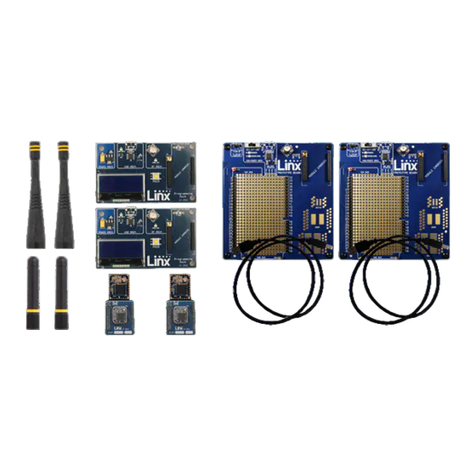
Linx
Linx HumPRO Series Instruction Manual
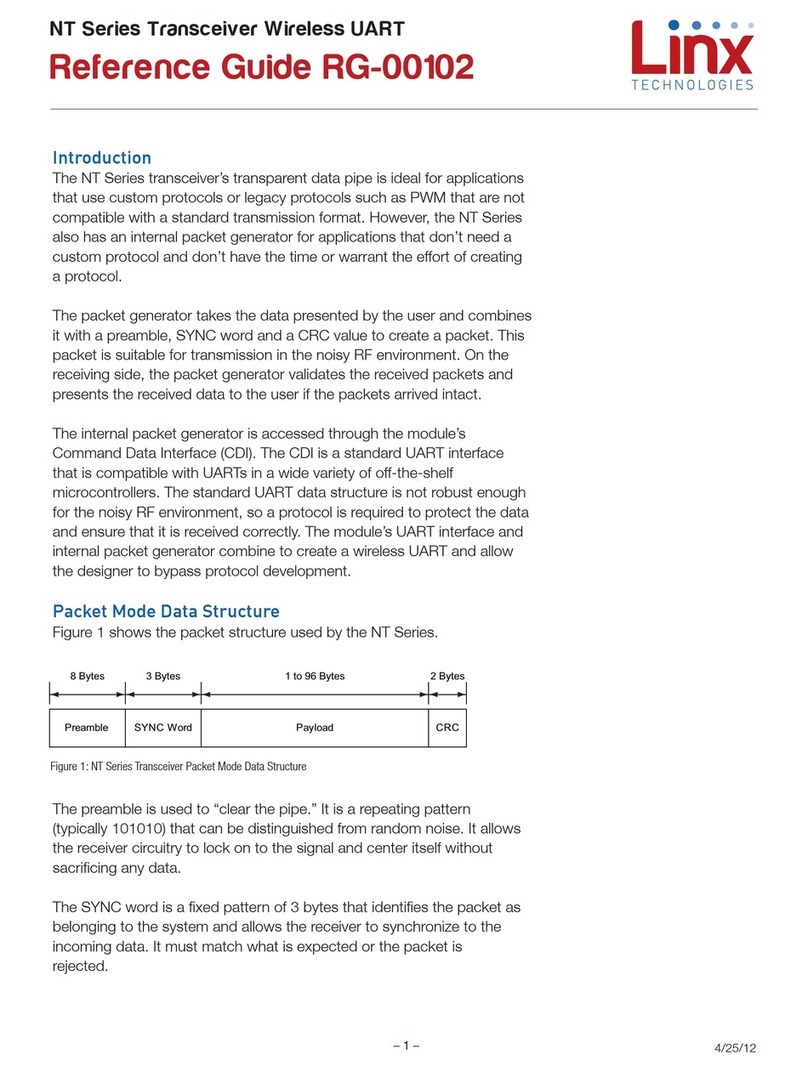
Linx
Linx NT Series User manual
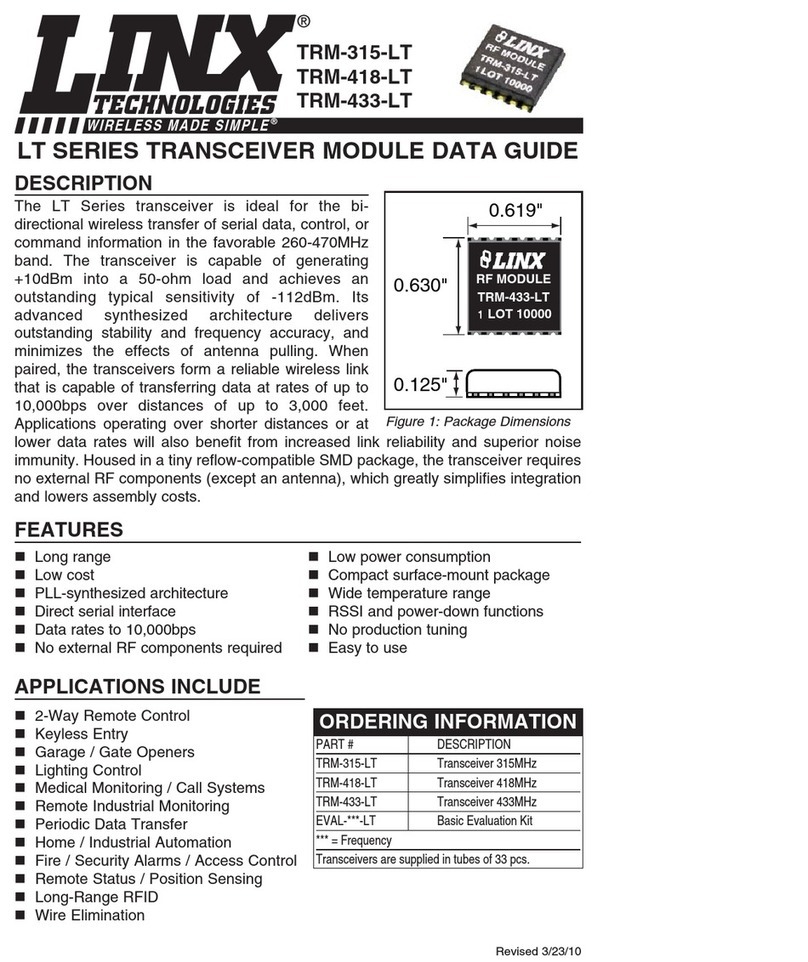
Linx
Linx TRM-315-LT Instruction Manual

Linx
Linx NT Series Instruction Manual
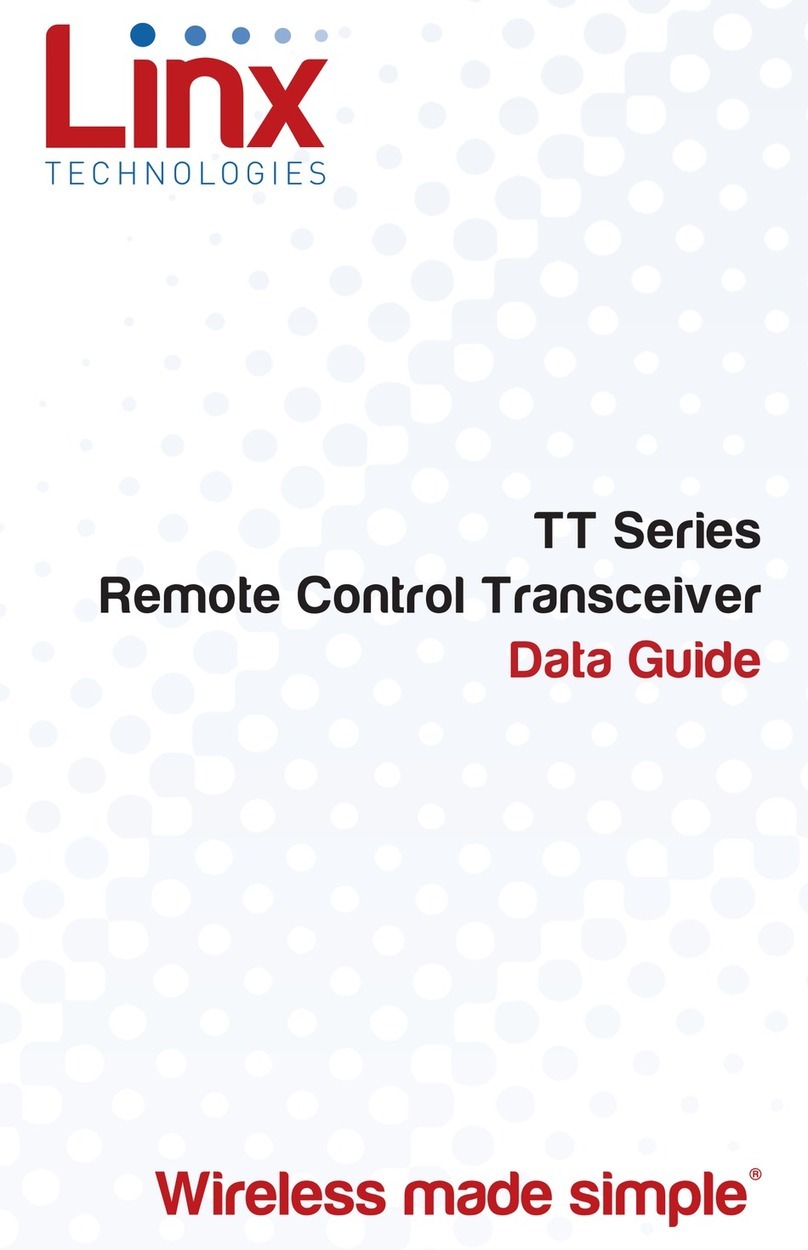
Linx
Linx TRM-900-TT Instruction Manual
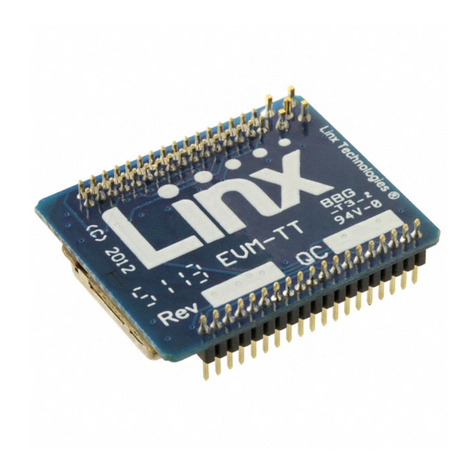
Linx
Linx TT Series Instruction Manual

Linx
Linx HUM-A-900-PRO-UFL Instruction Manual

Linx
Linx HumDT Series User manual


